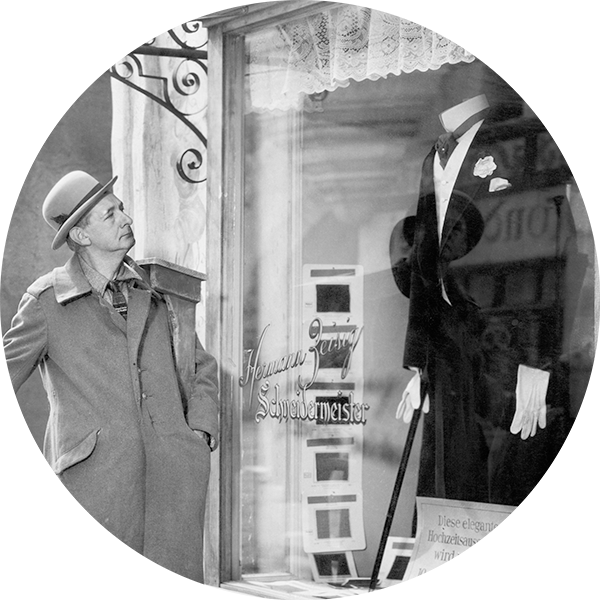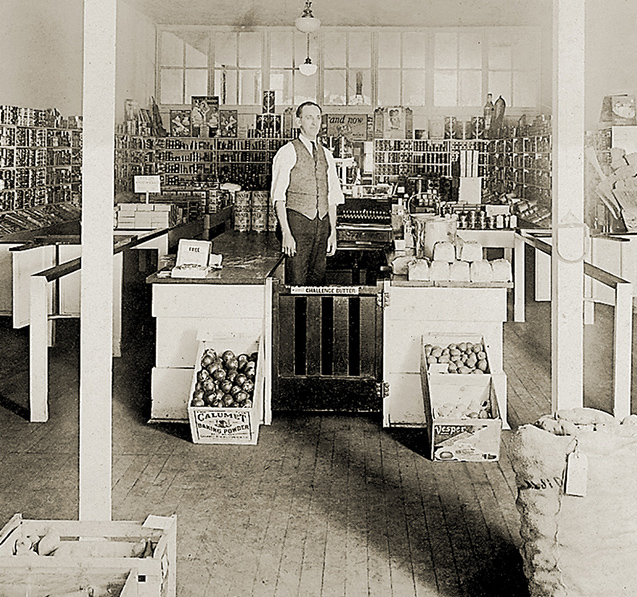THE EVOLUTION OF THE STORE – 1900-1939
1900 – 1939
The Art of Emotion
The beginning of the 20th century was a period of innovation for retail stores, taking the independent customer purchase journey we saw emerge at the end of the previous century one step further. Shortly after the end of the First World War, the mood was one of an explosion of the senses. There was the advent of a new format of shopping, the “supermarket”, whilst retailers of all kinds plunged into improving the atmosphere of their store: the customer experience was becoming emotional.
Immerse yourself in the stores of the time with our Early 20th Century Playlist!
Emotional Retailing
Emotion and the senses have always been intrinsically linked to the quality of the retail customer experience. In the 19th century, this concept gained momentum with the emergence of department stores. With their size, range of products, and use of the major technological innovation of the time: electricity, department stores succeeded in exciting customers and laying the foundations of brick-and-mortar retail as we know it today. The department store was also responsible for establishing a never before seen link between art and commerce, thus placing emotion and sensorial elements as the main drivers of the customer experience.
Seduction has always been an important part of consumerism and one man who knew that all too well was American retail magnate Harry Gordon Selfridge. Opened in London in 1909, Selfridges offered (and still does to this day) bedazzled customers a maze of floors with hundreds of departments, not to mention restaurants, a roof garden, reading and writing rooms, reception areas for foreign visitors, a first aid room and, most importantly, a small army of knowledgeable assistants manning the floors.
The spacious, well-furnished toilets and lounges of the stores of this time brought retail closer to women’s circles. At the beginning of the 20th century, hairdressing salons appeared, followed by courses to learn how to do one’s hair, apply make-up, and walk with elegance. Tailor-made clothes, wedding dress salons, and fashion shows helped attract an even more affluent clientele that had previously disdained department stores and their product offerings.
Selfridge did much to make the department store a destination rather than just a large and comprehensively stocked shop. The goal was for the customer to have an engaged experience, to keep them browsing, and most importantly spending money in the store, for the maximum amount of time possible.
Under the Neon Lights!
Towards the end of the 18th century, we saw the first modern shop window displays appear in London, thanks to the industrialisation of glass and the widespread use of electricity. The window display has since become an important tool in improving the customer experience for retailers and an effective lever for sales growth. One only has to pass by the windows of Galeries Lafayette in Paris or Harrods in London, especially around Christmas time, to realise the power of this marketing strategy in attracting crowds of admirers each year to ogle over these inventive works of art.
Back in 1910, with the patenting of the neon sign, shopfronts were becoming adorned with light to attract shoppers and gain visibility at nightfall, encouraging and enabling passers-by to window shop right into the evening. The theatrical approach to using window displays as spectacles to entice consumers in-store was further enhanced by realistic wax mannequins that replaced the simple displays and mannequins without heads or limbs used up until this point in retail stores. Parisian firms such as “Siegel & Stockman” and “Pierre Imans” offered models with articulated limbs that could assume poses very similar to the people looking at them. Window dressers were now able to design stagings evoking realistic situations with mannequins as their actors.

Marketing Back to Basics
However, the shop window was not the only visual means of attracting customers to retail outlets; in fact, advertising was starting to take on a new format, going beyond the simple framework of leaflets distributed at the foot of shops. In 1908 for example the Mitsukoshi department stores’ put up a billboard on the summit of Mount Fuji proclaiming that it was the No.1 department store in Japan!
Advertising was becoming a new area of business, now studied by specialists and giving birth to a new profession which was beginning to theorise the broad outlines of the field. It was also during these years that the first courses started to be offered to scholars at the world’s now most famous business schools. The customer experience and purchase journey, through this new intermediary, was now moving away from starting at the store to beginning with attracting potential customers from the streets and their homes.
Self-service in the Spotlight
Following in the footsteps of the department store, grocers, faced with consumers who had gained, and were enjoying, independence in their own purchase journey, turned to optimising flow management within the food retail industry in order to sell ‘en masse’. In 1916, Memphis, Tennessee, Clarence Saunders created the first self-service grocery store. This first ‘Piggly Wiggly’ originated many of the features we see in a modern supermarket including self-service, aisles, checkout stands, prices on individual items, and shopping carts.
The store was set up so that shoppers followed a continuous path which brought them in front of all the products the store sold. Saunders received patents for the “Self-Serving Store,” the store’s design, individual price tags on items, and the printed cash receipt. By 1923, there were 1,267 Piggly Wiggly stores across the U.S. This was a new stage in the revolution of the in-store customer experience.
The Arrival of the Supermarket
At the end of a bloody First World War, European countries were in the midst of mass reconstruction, while the American economy was booming. In the distribution sector, the logic of flow management became widespread, fuelled by Taylorian theories and the principles of division of labour. As part of these logistical advances, the first true supermarket in the U.S. was created by a former Kroger employee named Michael J. Cullen. Cullen launched the first King Kullen store on August 4, 1930, inside a disused garage located in Jamaica, Queens, New York.

Kullen’s innovations included separate food departments, a parking lot, and the selling of large volumes of food at discount prices. King Kullen’s stores’ slogan was “Pile it high. Sell it low.” By 1936, there were 17 King Kullen supermarkets earning over $6 million annually. During the next ten years, these new-found supermarkets began to muscle out “mom and pop” grocery stores across the country because they could offer food at lower prices due to their much larger buying power.
The customer purchase journey was now completely independent, with the days of greengrocers for fruits and vegetables, butchers for meat, fishmongers for fish, and dry goods stores for soap and cleaning supplies, falling behind. What helped the evolution move as quickly as it did was the attractive pricing policy of supermarkets that attracted large crowds, particularly from working-class backgrounds. The supermarket was born and went from strength to strength; in 1934, there were already 94 supermarkets, rising to 1,200 by 1936, across 95 U.S. towns and cities!
Europe, still in ruins, preferred to concentrate its efforts on the retail sector, to which it applied increasingly marketed concepts. However the supermarket soon crossed the Atlantic, and on 1 December 1931, the first Prisunic opened on rue Caumartin in Paris. The concept was the same as Cullen’s: a popular store selling mass-produced goods at low prices. It was also at this time, simultaneously in the United States and France, that a few pioneers were laying the foundations for a system of associations that would later give rise to the franchise concept.

Muzak, Maestro!
During this time, sensorial marketing was making its debut as an in-store marketing concept. In the early 1920s, George Owen Squier, an American scientist, inventor, and Signal Corp Officer, discovered a method of transmitting information via electrical wires and realised that this new method could be used to distribute music. Squier was granted several patents for his ideas, realising that wire transmission had great potential for delivering music to a large audience. He sold these patents to a utility conglomerate called the North American Radio Company, and a new company was formed called Wired Radio Inc. The plan was to sell music subscriptions to the power company’s existing utility customers. And in 1934, the music subscription service known as Muzak was created, (later acquired by Mood Media).
By the end of 1934, Muzak began to market their easy-listening background music services to shops, offices, and even factories, to accompany workers during their working day. The customer experience, and even the employee experience, had begun to take on a new sensory dimension thanks to music.
To Recap, the Customer Experience Gets Emotional
The beginning of the 20th century, marked by the First World War, saw the development of the customer experience continue in both the retail, and the food distribution sectors, offering different ways of shopping. Forget about the consumer buying journey beginning at the point of sale, this period marked a change which saw the journey start directly at the consumer’s home: an advertisement in a magazine draws them to the high street, a beautiful window display entices them to enter the store, and finally the ease of self-service or the comfort and pleasure offered by the in-store experience convinces them to make a purchase. The customer experience is no longer just physical, it has just integrated a new key factor: emotion!
